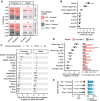Activation-induced cytidine deaminase causes recurrent splicing mutations in diffuse large B-cell lymphoma
- PMID: 38402205
- PMCID: PMC10893679
- DOI: 10.1186/s12943-024-01960-w
Activation-induced cytidine deaminase causes recurrent splicing mutations in diffuse large B-cell lymphoma
Abstract
Diffuse large B-cell lymphoma (DLBCL) is the most common lymphoma. A major mutagenic process in DLBCL is aberrant somatic hypermutation (aSHM) by activation-induced cytidine deaminase (AID), which occurs preferentially at RCH/TW sequence motifs proximal to transcription start sites. Splice sequences are highly conserved, rich in RCH/TW motifs, and recurrently mutated in DLBCL. Therefore, we hypothesized that aSHM may cause recurrent splicing mutations in DLBCL. In a meta-cohort of > 1,800 DLBCLs, we found that 77.5% of splicing mutations in 29 recurrently mutated genes followed aSHM patterns. In addition, in whole-genome sequencing (WGS) data from 153 DLBCLs, proximal mutations in splice sequences, especially in donors, were significantly enriched in RCH/TW motifs (p < 0.01). We validated this enrichment in two additional DLBCL cohorts (N > 2,000; p < 0.0001) and confirmed its absence in 12 cancer types without aSHM (N > 6,300). Comparing sequencing data from mouse models with and without AID activity showed that the splice donor sequences were the top genomic feature enriched in AID-induced mutations (p < 0.0001). Finally, we observed that most AID-related splice site mutations are clonal within a sample, indicating that aSHM may cause early loss-of-function events in lymphomagenesis. Overall, these findings support that AID causes an overrepresentation of clonal splicing mutations in DLBCL.
Keywords: B-cell lymphoma; Somatic hypermutation; Splicing mutations.
© 2024. The Author(s).
Conflict of interest statement
The authors declare no competing interests.
Figures


References
Publication types
MeSH terms
Substances
Grants and funding
LinkOut - more resources
Full Text Sources

